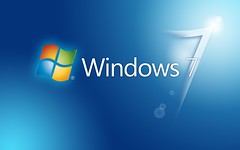Search This Blog
Dropbox is one of the coolest utilities available today to backup and share files and folders online. If you want easier access to it, you might want to add it to the Send To Menu in the Context Menu.
Add Dropbox to Send To Menu in Vista & Windows 7
First navigate to the following path by copying the following into the Windows Explorer address bar or the Search box in the Start Menu.
%APPDATA%\Microsoft\Windows\SendTo
If you have Dropbox under Favorites right-click on the folder and drag it into the SendTo folder. If it’s not under your Favorites in Explorer, just drag it to the SendTo folder from whatever directory you have it in.

When you release the folder you’ll have the option to move, copy, or create a shortcut…you can certainly move it there if you want, but we’re going to create a shortcut.

Now when you right-click on a file or folder you’ll have the option to send it to your Dropbox folder.

If you have other shared folders in your Dropbox folder you can add them to the SendTo Menu as well using the same method. Like in this example we added a shared Dropbox folder we use for testing geek stuff.

Add Dropbox to Send To Menu in XP
In XP go to Control Panel and Folder Options then select Show hidden files and folders.
 Navigate to C:\Documents and Settings\[User Name]\SendTo (where User Name is the name of your computer) and create a shortcut to your Dropbox folder.
Navigate to C:\Documents and Settings\[User Name]\SendTo (where User Name is the name of your computer) and create a shortcut to your Dropbox folder.
Now you have your Dropbox folder added to Send To in the Context Menu…

If you use Send To from the Context Menu in Windows, this is a good way to easily add files and folders to your Dropbox folders.
Make sure and check out our other tips and tricks for using Dropbox:
Different versions of Windows 7 and their benefits.
By Remote Computer Support on 11:35 PM
Filed Under: computers, home premium, ultimate, windows 7 professional, windows 7 versions
Windows 7 is available in different versions: Home Premium, Professional and Ultimate. You can choose one of these versions matching with your taste and preference.
• Windows 7 Home Premium version is for basic home usage and most suitable for students and people who work on a home network.
• Windows 7 Professional gives an additional backup, and restores all files and folders. It is well suited for all professional requirements, business and large organizations.
• Windows 7 Ultimate works in 35 languages and opens up big options for various types of groups. It gives an enhanced feature to protect data on your PC and for portable storage devices.
Windows 7 SP1 Beta Goes Public
By Remote Computer Support on 6:38 AM
Filed Under: windows 7, Windows 7 SP1, Windows 7 SP1 installed
Up until now the Windows 7 SP1 Beta has only been available to Technet or MSDN subscribers, so us common users haven’t been able to get our hands on it. Well for those of you who are early adopters and anxious to try it out, now you can. All you need is a Windows Live ID which anyone can get (if you don’t already have one) and head on over to the Microsoft Eval Center to download the beta right now.
Now if you don’t fancy installing the beta of Windows 7 SP1, don’t worry because you’re not really going to be missing out on a whole lot to be honest. There is no new features coming in the first service pack for Windows 7 and Microsoft see it only as a minor update for the operating system, it’s just to fix the odd little bug here and there and improve security.
However, in reality, you probably have Windows 7 SP1 installed on your PC, it’s really just a combination of all the patches and security updates that have been released by Microsoft and in theory should have been installed automatically on your machine by the Windows Update facility.
And if you do go and install Windows 7 SP1, there’s probably quite a good chance that you will have to uninstall it sometime in the future when the code has been finalized. Very rarely will you find that a beta release is the same code as the final release.
The full RTM isn’t expected until Q2 2011 so maybe if you’re really eager to try out SP1, you should download it now if you can’t wait.
Source http://www.windows7news.com/
Do the Microsoft Windows 7 Sold Numbers Really Add Up?
By Remote Computer Support on 6:34 AM
Filed Under: how to windows 7, Microsoft Windows 7
Microsoft, and a number of other people, and blogs have been touting the success of Windows 7. Part of the effect has been that many computers are selling as a result of Windows 7. However, several sites have reported that this may not be the case.
One survey came from Fiberlink Communications, a business analyst firm that sells a service, which allows organizations find out what software versions are on their endpoints. They recently did a survey of 500,000 computers owned by their customers and found that nearly 17 percent were running XP SP2. Fiberlink customers include stalwart companies such as Bayer, Volkswagen and Pepsi. Their research found that Windows 7 was running on barely .33 percent of computers in their survey pool, with 2.96 percent running Windows 2000, 15.14 percent running Windows Vista, and a whopping 81.57 percent running Windows XP.
Another poll, by PC Advisor, showed that only one in six users, or 15.4 per cent, said they would upgrade to Windows 7. Even fewer than that, about 5.7 per cent, said they would stick with their current version of Windows XP, SP2 or an earlier Service Pack. About 5.1 per cent said they would make the upgrade to Windows XP SP3. It seems that most respondents are satisfied with XP, and that may be the biggest challenge to Windows 7.
The Service Pack for Windows XP
Microsoft has announced the end of support for Windows XP Service Pack 2. So customers will want to upgrade to Service Pack 3. Microsoft released XP SP3 in May 2008. It was a large 316MB package that included the fixes from the previous two service packs plus additional ones.
Fiberlink indicated that the Microsoft announcement ending Service Pack 2 support would prompt companies to move to Windows7; but maybe not right away. Companies may tolerate a certain amount of risk and uncertainty for a couple of months before they make the migration move. Another factor to consider in making to move to Windows 7 is improving economic conditions plus cheaper hardware. However, right now, XP still dominates.
Source http://www.windows7news.com/

